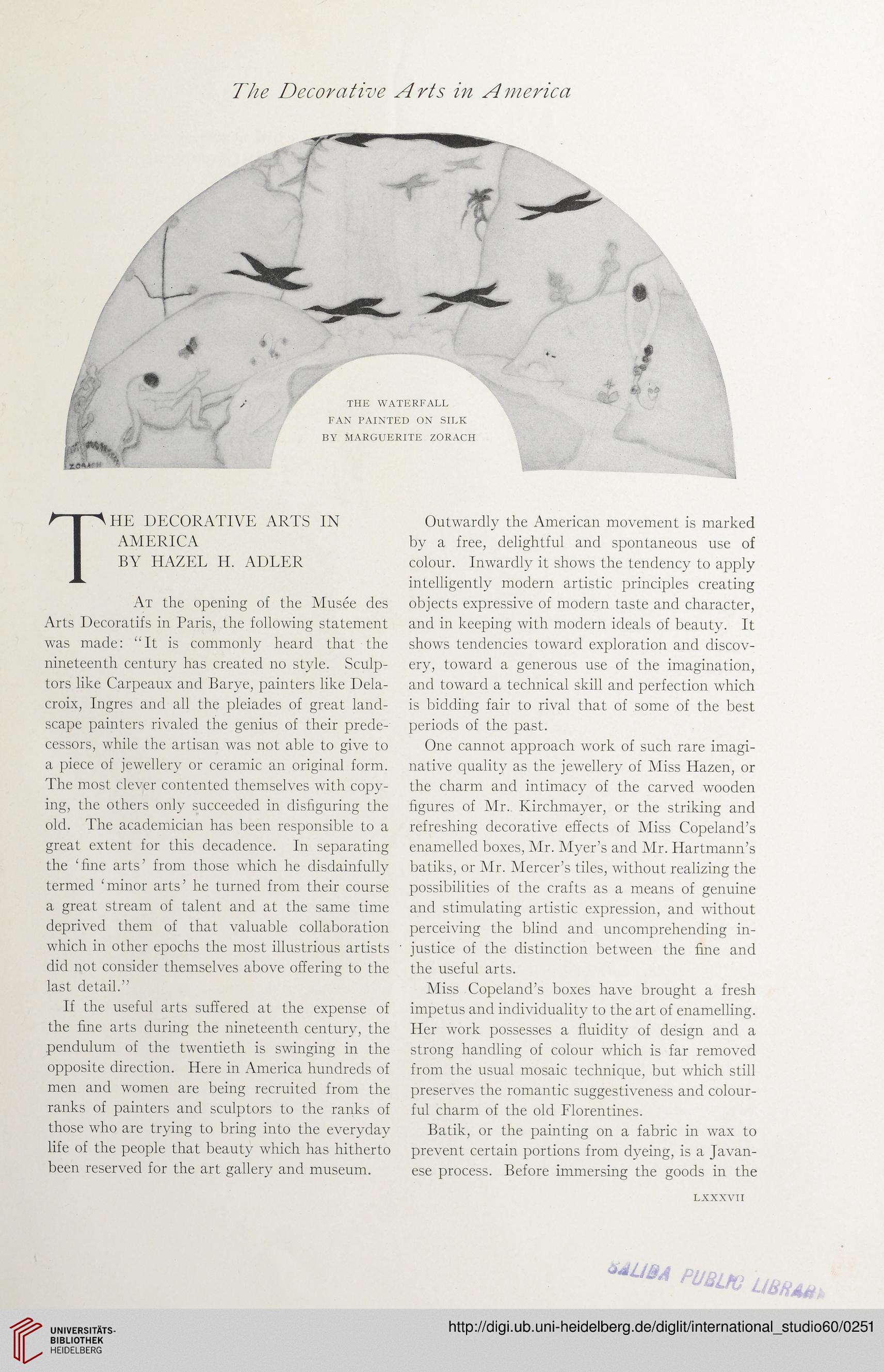The Decorative Arts in America
The decorative arts in
AMERICA
BY HAZEL H. ADLER
At the opening of the Musee des
Arts Decoratifs in Paris, the following statement
was made: “It is commonly heard that the
nineteenth century has created no style. Sculp-
tors like Carpeaux and Barye, painters like Dela-
croix, Ingres and all the pleiades of great land-
scape painters rivaled the genius of their prede-
cessors, while the artisan was not able to give to
a piece of jewellery or ceramic an original form.
The most clever contented themselves with copy-
ing, the others only succeeded in disfiguring the
old. The academician has been responsible to a
great extent for this decadence. In separating
the ‘fine arts’ from those which he disdainfully
termed ‘minor arts’ he turned from their course
a great stream of talent and at the same time
deprived them of that valuable collaboration
which in other epochs the most illustrious artists
did not consider themselves above offering to the
last detail.”
If the useful arts suffered at the expense of
the fine arts during the nineteenth century, the
pendulum of the twentieth is swinging in the
opposite direction. Here in America hundreds of
men and women are being recruited from the
ranks of painters and sculptors to the ranks of
those who are trying to bring into the everyday
life of the people that beauty which has hitherto
been reserved for the art gallery and museum.
Outwardly the American movement is marked
by a free, delightful and spontaneous use of
colour. Inwardly it shows the tendency to apply
intelligently modern artistic principles creating
objects expressive of modern taste and character,
and in keeping with modern ideals of beauty. It
shows tendencies toward exploration and discov-
ery, toward a generous use of the imagination,
and toward a technical skill and perfection which
is bidding fair to rival that of some of the best
periods of the past.
One cannot approach work of such rare imagi-
native quality as the jewellery of Miss Hazen, or
the charm and intimacy of the carved wooden
figures of Mr. Kirchmayer, or the striking and
refreshing decorative effects of Miss Copeland’s
enamelled boxes, Mr. Myer’s and Mr. Hartmann’s
batiks, or Mr. Mercer’s tiles, without realizing the
possibilities of the crafts as a means of genuine
and stimulating artistic expression, and without
perceiving the blind and uncomprehending in-
justice of the distinction between the fine and
the useful arts.
Miss Copeland’s boxes have brought a fresh
impetus and individuality to the art of enamelling.
Her work possesses a fluidity of design and a
strong handling of colour which is far removed
from the usual mosaic technique, but which still
preserves the romantic suggestiveness and colour-
ful charm of the old Florentines.
Batik, or the painting on a fabric in wax to
prevent certain portions from dyeing, is a Javan-
ese process. Before immersing the goods in the
LXXXVII
PUSLK UBHJUt
The decorative arts in
AMERICA
BY HAZEL H. ADLER
At the opening of the Musee des
Arts Decoratifs in Paris, the following statement
was made: “It is commonly heard that the
nineteenth century has created no style. Sculp-
tors like Carpeaux and Barye, painters like Dela-
croix, Ingres and all the pleiades of great land-
scape painters rivaled the genius of their prede-
cessors, while the artisan was not able to give to
a piece of jewellery or ceramic an original form.
The most clever contented themselves with copy-
ing, the others only succeeded in disfiguring the
old. The academician has been responsible to a
great extent for this decadence. In separating
the ‘fine arts’ from those which he disdainfully
termed ‘minor arts’ he turned from their course
a great stream of talent and at the same time
deprived them of that valuable collaboration
which in other epochs the most illustrious artists
did not consider themselves above offering to the
last detail.”
If the useful arts suffered at the expense of
the fine arts during the nineteenth century, the
pendulum of the twentieth is swinging in the
opposite direction. Here in America hundreds of
men and women are being recruited from the
ranks of painters and sculptors to the ranks of
those who are trying to bring into the everyday
life of the people that beauty which has hitherto
been reserved for the art gallery and museum.
Outwardly the American movement is marked
by a free, delightful and spontaneous use of
colour. Inwardly it shows the tendency to apply
intelligently modern artistic principles creating
objects expressive of modern taste and character,
and in keeping with modern ideals of beauty. It
shows tendencies toward exploration and discov-
ery, toward a generous use of the imagination,
and toward a technical skill and perfection which
is bidding fair to rival that of some of the best
periods of the past.
One cannot approach work of such rare imagi-
native quality as the jewellery of Miss Hazen, or
the charm and intimacy of the carved wooden
figures of Mr. Kirchmayer, or the striking and
refreshing decorative effects of Miss Copeland’s
enamelled boxes, Mr. Myer’s and Mr. Hartmann’s
batiks, or Mr. Mercer’s tiles, without realizing the
possibilities of the crafts as a means of genuine
and stimulating artistic expression, and without
perceiving the blind and uncomprehending in-
justice of the distinction between the fine and
the useful arts.
Miss Copeland’s boxes have brought a fresh
impetus and individuality to the art of enamelling.
Her work possesses a fluidity of design and a
strong handling of colour which is far removed
from the usual mosaic technique, but which still
preserves the romantic suggestiveness and colour-
ful charm of the old Florentines.
Batik, or the painting on a fabric in wax to
prevent certain portions from dyeing, is a Javan-
ese process. Before immersing the goods in the
LXXXVII
PUSLK UBHJUt





